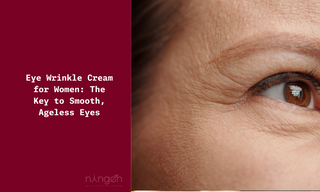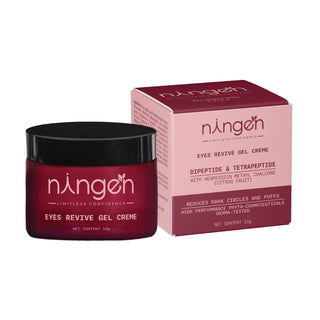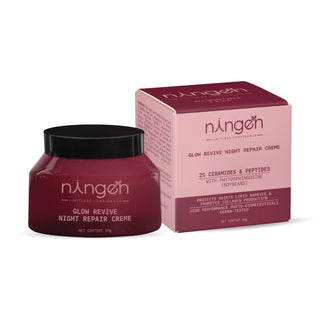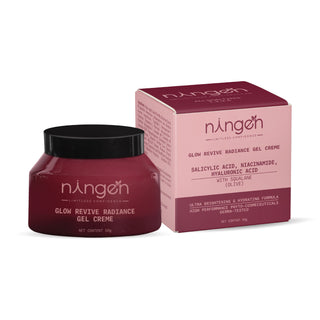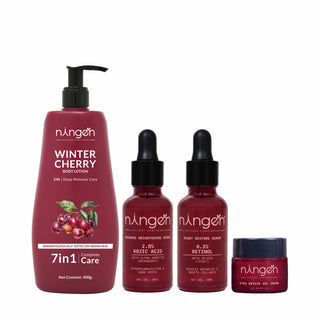No one likes waking up to puffy eyes, dark circles, or those little lines that appear overnight. Whether it’s from late nights, stress, or just the natural aging process, the skin around our eyes is often the first place to show signs of fatigue. And because it’s thinner and more delicate than the rest of our face, it needs a little extra love.
A good eye cream can help refresh, firm, and brighten your look. With countless products promising miracles, how do you choose? This guide on eye wrinkle cream for women cuts through the noise, explaining what really works to combat wrinkles, which ingredients deliver results, and how to pick the best cream for your needs. No fluff—just clear advice to help you achieve smoother, younger-looking eyes.
Let’s find your perfect match!
In this Guide;
Key Ingredients in Eye Wrinkle Creams
Tailoring Eye Creams to Skin Types
Common Misconceptions and Myths
What Are Eye Wrinkles?
Eye wrinkles are those little lines that form around your eyes as you age. They start as fine "crow's feet" when you smile or squint, and over time, they can become more noticeable even when your face is relaxed.
Why do they happen?
-
Your skin gets thinner and drier with age
-
Sun damage breaks down collagen (your skin's "support beams")
-
Repeated facial movements (like smiling or rubbing your eyes) create creases
-
Lack of sleep and dehydration make them more obvious
What Causes Eye Wrinkles?
Eye wrinkles—those fine lines and creases around your eyes—don’t just appear overnight. They develop over time due to a mix of natural aging and lifestyle factors. Here’s what’s causing them:
1. Aging (The Biggest Culprit)
-
Your skin produces less collagen and elastin (the proteins that keep skin firm) as you age.
-
The skin around your eyes is already thin, so wrinkles show up here first.
2. Sun Damage
-
UV rays break down collagen and weaken the skin’s structure.
-
Without sunscreen, wrinkles form faster (even on cloudy days!).
3. Facial Expressions (Yes, Really!)
-
Smiling, squinting, and frowning create "dynamic wrinkles" (like crow’s feet).
-
Over time, these temporary lines become permanent.
4. Dry Skin & Dehydration
-
When skin lacks moisture, fine lines look deeper.
-
Harsh skincare or weather can make wrinkles more noticeable.
5. Poor Sleep & Stress
-
Lack of sleep = puffy eyes + darker circles, making wrinkles stand out.
-
Stress increases cortisol, which speeds up skin aging.
6. Rubbing Your Eyes
-
Tugging at delicate eye skin stretches it, leading to sagging and wrinkles.
7. Smoking & Unhealthy Diet
-
Smoking reduces blood flow, starving skin of oxygen and nutrients.
-
Sugar and processed foods damage collagen over time.
The Good News? You Can Slow Them Down!
While you can’t stop aging, you can protect your skin with:
✔ A good eye cream (with retinol, hyaluronic acid, or peptides)
✔ Daily sunscreen (even on your eyelids!)
✔ Gentle skincare (no harsh rubbing!)
✔ More sleep & water (your skin will thank you)
The Importance of Early Prevention: Key Strategies
The delicate skin around our eyes is the first place to show aging because it's thinner and more fragile than facial skin. Without proper care, temporary fine lines turn into permanent wrinkles, dark circles deepen, and skin loses its youthful bounce.
Early prevention is crucial because:
-
Wrinkles become harder to reverse once collagen breaks down
-
Sun damage accumulates over time, accelerating aging
-
Dryness and stress make fine lines more noticeable faster
Starting a targeted eye care routine before wrinkles appear keeps the area smooth, bright, and resilient for years to come. Think of it as "saving" your skin's youth—the sooner you begin, the better your results!
Also read: How to choose the best eye cream for wrinkles.
Benefits of Eye Wrinkle Creams
The right eye wrinkle cream does more than just moisturize—it actively works to combat signs of aging while delivering visible improvements. Here’s why incorporating one into your routine is a game-changer:
1. Reduces Fine Lines & Wrinkles
-
Stimulates collagen to plump skin and smooth crow’s feet
-
Hydrates deeply to soften existing wrinkles and prevent new ones
2. Brightens Dark Circles
-
Improves circulation to reduce under-eye shadows
-
Contains light-reflecting pigments for an instant refreshed look
3. Firms & Tightens Sagging Skin
-
Peptides and retinol boost elasticity for a lifted effect
-
Strengthens skin barrier to prevent thinning and crepiness
4. Depuffs & Refreshes Tired Eyes
-
Caffeine and cooling agents reduce morning puffiness
-
Soothes irritation from lack of sleep or allergies
5. Protects Against Future Damage
-
Antioxidants (like Vitamin C) fight free radicals from UV/screen time
-
SPF-infused formulas shield delicate skin from sun damage
6. Enhances Makeup Application
-
Creates a smooth, hydrated base so concealer doesn’t settle into lines
-
Non-greasy textures prevent smudging or creasing

Benefits of eye wrinkle creams
Key Ingredients in Eye Wrinkle Creams
To maintain smooth, ageless eyes, it is crucial to use eye wrinkle creams that are rich in potent ingredients. These ingredients are formulated to target signs of aging such as fine lines, wrinkles, and puffiness, especially in the delicate under-eye area. By understanding these key components, you can choose products that will enhance your skin's texture, firmness, and hydration.
1. Retinol: The Gold Standard for Anti-Aging
This vitamin A derivative is dermatologists' top choice for:
-
Stimulating collagen production to fill in fine lines
-
Accelerating cell turnover for smoother texture
-
Improving skin elasticity over time
Ideal for: Noticeable wrinkles, loss of firmness
Pro Tip: Pair with moisturizer to minimize initial dryness
2. Peptides: Nature's Skin Tighteners
These amino acid chains work like cellular messengers to:
-
Trigger collagen synthesis for natural lifting effect
-
Fortify skin structure against sagging
-
Repair damage from environmental stressors
Bonus: Gentler than retinol, perfect for sensitive skin
3. Hyaluronic Acid: The Ultimate Plumper
The skin's natural moisture magnet:
-
Instantly hydrates to reduce wrinkle depth
-
Creates a protective veil against moisture loss
-
Works at multiple skin levels for lasting effects
Fun Fact: Can hold moisture equal to 1000x its weight!
4. Niacinamide: The Multitasking Marvel
Vitamin B3's impressive resume includes:
-
Brightening stubborn dark circles
-
Reducing inflammation and redness
-
Regulating oil production (even for mature skin)
Special Power: Enhances effectiveness of other actives
5. Citrus Bioflavonoids (Hesperidin Methyl Chalcone): The Circulation Specialist
Derived from citrus rinds, this ingredient:
-
Strengthens fragile capillaries that cause dark circles
-
Has potent antioxidant protection
-
Reduces fluid retention causing puffiness
Key Benefit: Addresses both blue-toned and puffy under-eyes
Tailoring Eye Creams to Skin Types
1. For Sensitive Skin
-
Look for: Fragrance-free, hypoallergenic formulas
-
Key Ingredients:
-
Aloe vera (soothes irritation)
-
Hyaluronic acid (gentle hydration)
-
Ceramides (strengthens skin barrier)
-
Avoid: Strong retinoids, synthetic fragrances
2. For Oily/Acne-Prone Skin
-
Look for: Oil-free, non-comedogenic gels/serums
-
Key Ingredients:
-
Niacinamide (controls oil, minimizes pores)
-
Caffeine (reduces puffiness without greasiness)
-
Green tea extract (anti-inflammatory)
-
Avoid: Heavy creams, mineral oils
3. For Dry Skin
-
Look for: Rich, emollient creams
-
Key Ingredients:
-
Shea butter (deep moisture)
-
Squalane (lightweight yet nourishing)
-
Glycerin (locks in hydration)
-
Bonus: Overnight masks for intensive repair
4. For Mature Skin
-
Look for: Multi-action treatments
-
Key Ingredients:
-
Retinol (collagen booster)
-
Peptides (firms sagging skin)
-
Vitamin C (brightens age spots)
Pro Tip: Always patch test new products! The eye area is delicate—what works for cheeks may irritate eyelids.
Also read: 7 benefits of using natural eye creams for puffiness.
Common Misconceptions and Myths
Myth 1: "One cream fits all."
-
Truth: Skin types vary dramatically - retinol may irritate sensitive skin while gel formulas might not hydrate dry skin enough
Myth 2: "Natural ingredients don't work."
-
Truth: Plant extracts like aloe, citrus fruits and green tea, paired with science-backed actives (like hyaluronic acid), create powerful synergies
Myth 3: "You must splurge for results"
-
Truth: Effective drugstore options exist - what matters is the active ingredients (peptides, caffeine, etc.), not the price tag
Pro Tip: Focus on your specific concern (dark circles? wrinkles?) and skin type when choosing - not marketing claims!
The Bottom Line
We've covered the essentials of choosing the best eye wrinkle cream, but skincare is personal! What’s your experience?
We'd love to hear from you:
-
Have you found a holy-grail eye cream? Share your favorite!
-
What’s your biggest under-eye struggle (wrinkles, dark circles, puffiness)?
-
Any pro tips you’ve discovered?
Drop your thoughts in the comments, your advice might help someone find their perfect match!
Source: https://pubmed.ncbi.nlm.nih.gov/19735523/
https://www.ncbi.nlm.nih.gov/books/NBK482304/
TLDR: (too long, didn’t read)
Effective eye wrinkle treatment requires science-backed actives: retinol boosts collagen, hyaluronic acid plumps, peptides firm, and caffeine depuffs. Match formulations to skin needs—ceramides for sensitivity, retinoids for maturity. Begin prevention early (mid-20s+) with SPF and antioxidants. Clinical-strength retinols (0.3%+) show proven efficacy. Always apply gently. For optimal results, consult a dermatologist for personalized regimens combining proven ingredients with proper application techniques.
Frequently Asked Questions
Q1. What is the best eye cream for wrinkles?
The best eye cream for wrinkles typically contains clinically proven ingredients like retinol (boosts collagen), hyaluronic acid (plumps skin), and peptides (improves elasticity). Look for dermatologist-recommended options like [Product Example] for visible reduction in fine lines and crow’s feet.
Q2. Can eye cream really reduce dark circles and wrinkles?
Yes! The best eye cream for dark circles and wrinkles combines caffeine (reduces puffiness), vitamin C (brightens), and retinol (smooths texture). Consistent use improves circulation and collagen production for a fresher look.
Q3. How do I choose the right under-eye wrinkle treatment?
Consider your skin type:
-
Dry skin? Try rich creams with hyaluronic acid.
-
Oily/sensitive? Gel-based formulas with niacinamide work best.
-
Mature skin? Opt for retinol or peptide-infused treatments.
Q4. When should I start using an eye cream?
Prevention is key! Dermatologists recommend starting in your mid-20s to early 30s with hydrating formulas, then transitioning to anti-aging ingredients (like retinol) by your 40s.
Q5. Are expensive eye creams worth it?
Not always! Effective drugstore options (like [Budget-Friendly Brand]) often contain similar actives (peptides, caffeine) as luxury brands. Focus on ingredients over price.
Q6. How long does it take to see results from eye cream?
Most creams show initial hydration in 1–2 weeks, but wrinkle reduction takes 4–8 weeks of consistent use. For best results, apply AM/PM and pair with SPF.


